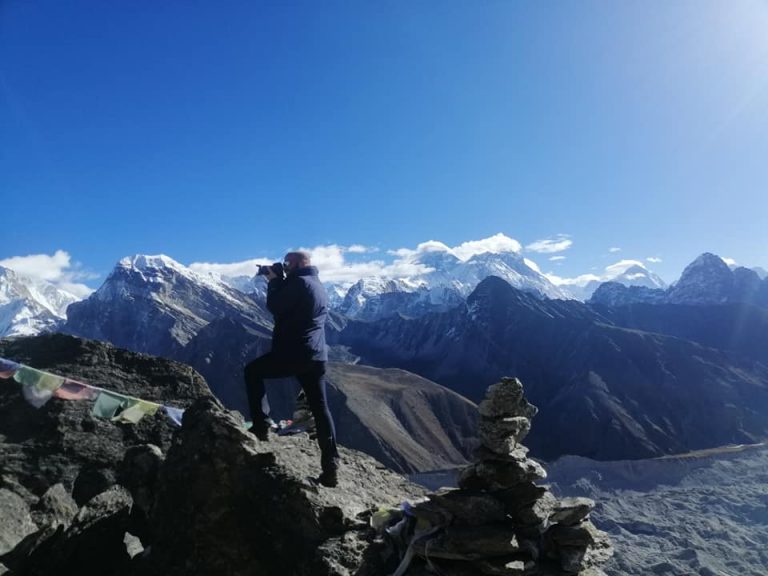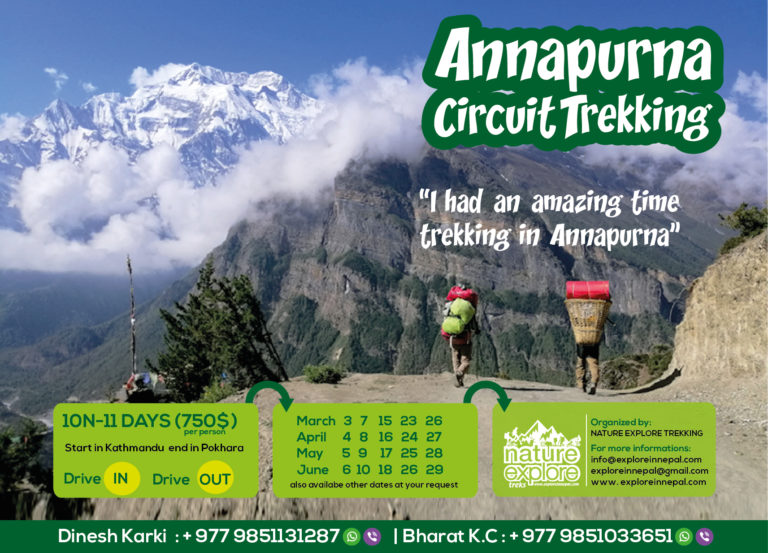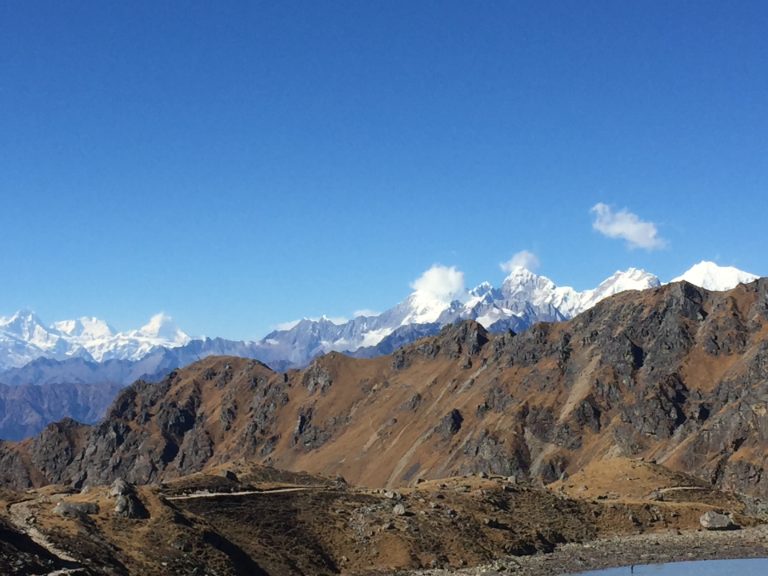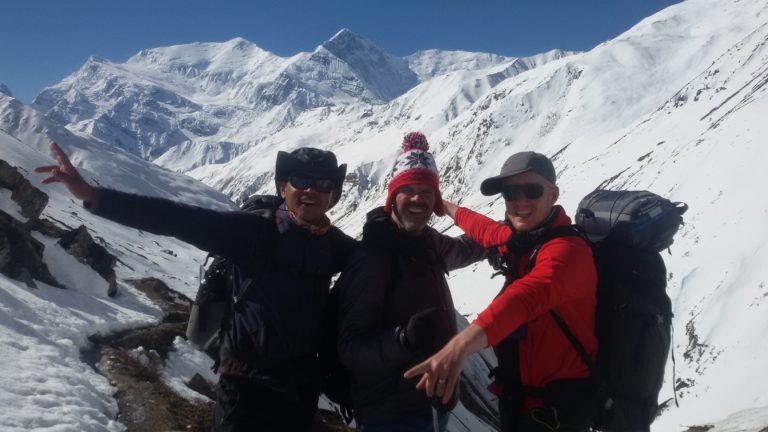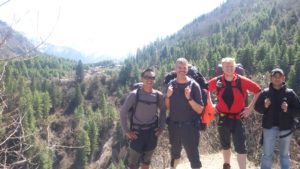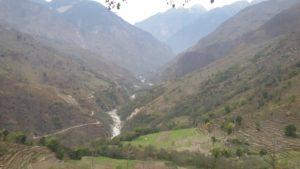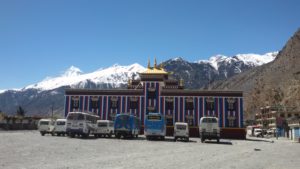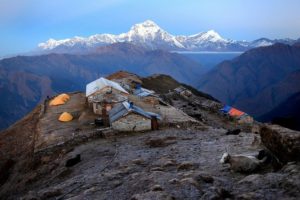Trekking in Nepal, October, and November is the best moths, October and November is autumn in Nepal, in this season you can see very clear mountain view most of the time, and in the mountain, the temperature is neither hot nor cold, less cloudy, and not rain and then, while you trekking to mountains, you shall encounter the full of paddy farmer’s lands, and many beautiful and colorful local people habitation, their culture and religions.
We have hundreds of years of experience with good weather in October and November, in pleasurable weather, you would have majestic mountains views with clear blue sky, and beautiful landscapes are surrounded by fertile green farmlands, including you will have a great chance to see many Hindu and Buddhist festival events, like Dashaee, Tihar, Losar, Chhat many more, which is happening in this season, and we have a long experience about the weather in this season most of the timeless windy, less raining, not much cold from begging to September to till the end of the November cold wind is not properly descending to the lower valley of Himalaya, and most of the days will be sunshine made your holiday, good memories and life experience to travel in Nepal in October and November.
Nepal very reaches in nature and culture diversities always as old, this nature makes you very excited to be here. Beautiful nature always offers you many different types of indoor and outdoor activities like Tour, Trekking, Hiking, and climbing many more.
Why October and November is the best time for trekking in Nepal?
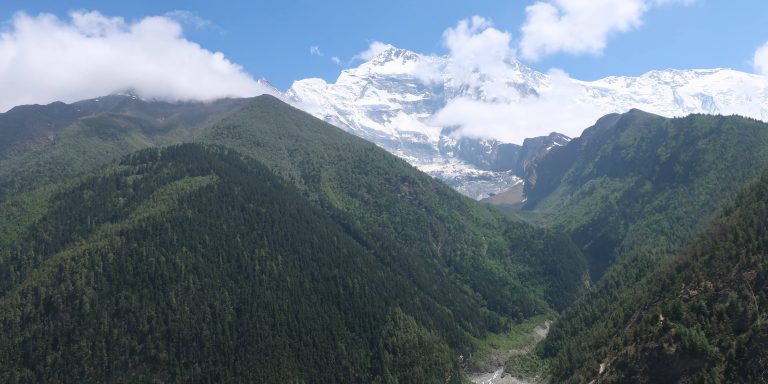 one the way to Thorong La pass trek,
one the way to Thorong La pass trek,
(1) Clear mountains view:
In October and November, the weather is preferable, and in the mountains, you would have a clear crystal, crispy blue Skye, very little chance to have cloudy, and rain and always sunshine day, which means you, can see strengthen Himalayas view most of the time. In these months the temperature will be very suitable, neither hot nor cold, still, cold winds are not descending below 5500m.
(2) Perfect weather and Temperature :
October and November are the perfect weather with middle temperature and the monsoon has just ended and leaves so much greenery with beautiful landscapes, and most of the days will be sunshine, but when you go out for photographer or hike in early morning and evening it will be bit colder but you won’t feel much cold because of the at night you shall stay in the tea house with an insulated window and warm dining hall and they also provided extra blankets which you can use on top of your sleeping bag.
In this season your holidays will be safe, more fun, comfortable with good climate, and hundreds percent you would have great trekking experience with deep memories from Nepal treks in October and November. But mountains weather could be change anytime, no buddy can guaranty so you should be well prepared before you travel to Nepal for trekking or climbing.
(3) Nepalese major Festival events :
After monsoon end from early autumn, Nepali festival is starting with more happiness and fun, Dashae and Tihar are the biggest and longest festival in Nepal.
We celebrate festivals such as Dashain, Tihar, Chhat, and Lothar together. So do not miss the great chance you too, celebrate the Nepali festival with us, everywhere in Nepal all Nepali people are happy to welcome you with them to celebrate the festivals.
October and November are crowding for trekking in Nepal?
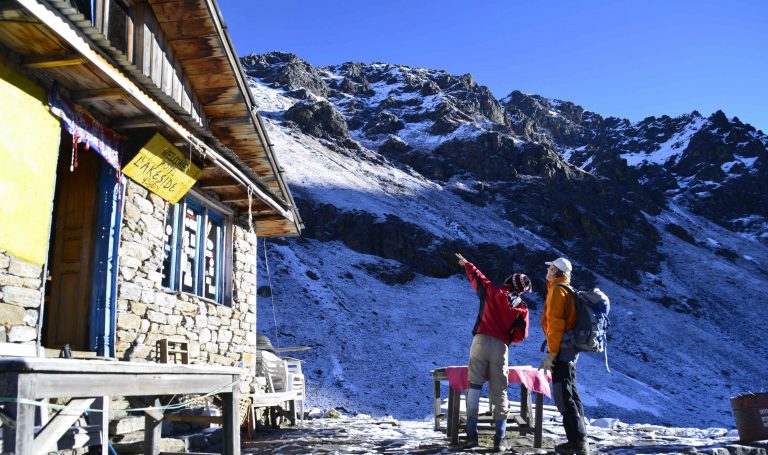 Gosaikunda lake is one of the most popular trekking routes in the Langtang region.
Gosaikunda lake is one of the most popular trekking routes in the Langtang region.
Yes, October and November are crowded than another trekking season in Nepal, and all adventure trekking and climbing lovers plan to visit in Nepal in Oct/Nov, Because of in these months the weather is very clear, and you can see mountains view anytime from any different angles while you are into the Himalayas. Less chance to rain, neither cold nor hot, not much windy in mountains, sunny days, all the travels, organizers, Airline, Hotel, local lodges are very busy for booking an advance for ensuring their lodges and hotels capacity, so we would highly advise to all of you, you please book your holiday for Oct/Nov an advance, than your Nepal organizer has enough time to arrange all in advance than you have confirmed your holiday without any problems even in high pick season and in mountains or any place.
Where to go, and what to do In Nepal in October and November?
In Nepal there are so many different types of indoor and outdoor activities are available such as
Trekking: if you are planning trekking in Nepal Oct/Nov than beautiful nature offers you so many different types of trekking routes in a different region of Himalaya like Everest region, Annapurna region, Langtang region, Manaslu region, Makalu base camp, Kanchenjunga base camp, and many more trekking routes are available. Read More
Peak climbing, Nepal is not only for trekking, and hiking, here are so many opportunities to climb below 7000m mountains, if you dreaming in future for climb higher mountains in the world then you need start climb from small peak, and build up your climbing career from basic knowledge, anyone from around the globe planning for climb small peak and do some trek as well for fewer weeks in Nepal, here we suggest you several trekking peaks for climb likely Mera peak alt. 6461m. Island peak alt. 6176m. Lobuche East peak alt. 6178m. Chulu west alt. 6469m and chulu far east alt. 6069m, Thorong peak alt 6140m, Yala peak alt. 5760m., Pisang peak alt 5880m, and Mt. Ama Dablam alt 6893m… many more. Read More
Tours: if you are well not fit for trekking and climbing, but still love to visit Nepal and don’t know what to do in Kathmandu during your stay here so the best option for you can do sightseeing in old Kathmandu, heritages sites, Pokhara full city sightseeing Chitwan jungle safari, and Lumbini lord Buddha birthplace many more … Read More
Mountain Flight: you can fulfill your dream to see the big mountain from close distance by flight, which is a short and scenic flight through the mountains in the early morning before sun embarks, during the flight you would able to see the several mountains view, and this short flight would be your life memorable with the great experience of fly above Himalaya. Read More
Day activities in Kathmandu: If you are in Nepal for short time and still want to get some short outdoor experience so here are many options like Shivapuri hike, Nagarkot hike, Trisuli river rafting, Shivapuri cycling tour, White Gumpa hike, Namo Buddha hike, half-day cycling, full-day rafting in Trisuli river Read More
Motorbike tour: if you looking for a motorbike ride in Nepal or Tibet, china, we organize in both countries through the different types of routes. We have been organizing many trips already, here we suggest you some popular riding routes: 3 days Kathmandu valley ride, 7 days Kathmandu – Chitwan- Lumbini- Palpa – Pokhara, 10 days Kathmandu – Lumbini – Chitwan- Pokhara- Muktinath – Pokhara tour many more routes are available.
Tibet Motorbike tour: In Tibet also we organize the tour suggested routes like. Lhasa – North Everest base camp, and return Kathmandu by rode 10 days tour, 11 days Kathmandu- west Tibet Kailash tour, 7 days Lhasa- EBC, and Lhasa tour. We use Himalayan royal enfilade 500cc and excellent route captain and mechanic, Read more
Popular trekking routes in Nepal in October and November?
(1) Everest base camp trek:
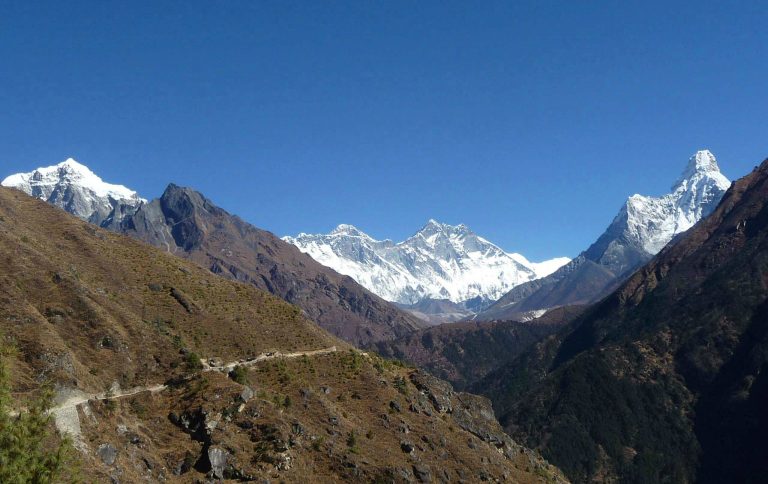 (one of the best mountain views from Namche to the Mount Everest region)
(one of the best mountain views from Namche to the Mount Everest region)
E.B.C TREK Trip Highlights
- Trek to Namche, a busy mountain hub surrounded by mountain views.
- We trek through Tengboche and visit the beautiful, high altitude monastery.
- When we reach Base Camp (5364m), we have plenty of time for pictures and to explore this iconic setting.
- Early morning climb of Kala Pattar (5550m), to watch the sunrise over Mount Everest
- We allow for several acclimatization days to ensure your trek is as comfortable as possible.
- We stay in teahouses along the route and you can experience Nepalese food and culture first hand
Trekking to Everest base camp in October and November is the best option to choose for all adventure lovers, in these months the weather will be perfect, sunshine day, and not cloudy, less cold than in winter, no rain, as well you would have a good opportunity to celebrate the Nepalese’s biggest festival in this time. Winter is very cold here and showing in the mountain, and monsoon is rain and cloudy so theses two seasons we don’t suggest you to go Everest base camp trek, but autumn, and spring best time for a trek in Nepal, so if you have a plan to go Everest base camp trek so we would highly recommend you October and Nov are the best time of year to hike up to world big mountains base camp in a clear sky, and comfortable temperature.
Everest region offers several trekking routes into the valley and among them, Everest base camp trek is more popular trekking routes. Everest base camp trek starts from Lukla after a scenic short (30 minutes) flight from Kathmandu, basically, you shall start to walk from Lukla, after a couple of days trek you will be reached in Namche bazaar alt. 3400m, Namche is the biggest local market in the valley where you can buy all types of trekking equipment, bakery, delicious food, and comfortable accommodation. Generally, you should stop one extra night in Namche for high altitude digest, in one extra day you can go short hike to Everest view Hotel alt. 3800m, to strengthen mountain view including mt. Everest range, you will also visit the old monastery, Sagarmatha national park museum. From next day you shall be continuously trekking to Everest base camp about four to five days through the Tenbuche – Dingbuche – Lobuche, and finally you will be reached in base camp at 5364m and then after exploring the basecamp and kalapather viewpoint you will trek back to Lukla another 3 to 4 days and fly back to Kathmandu. Read more.
(1) Everest view trek:
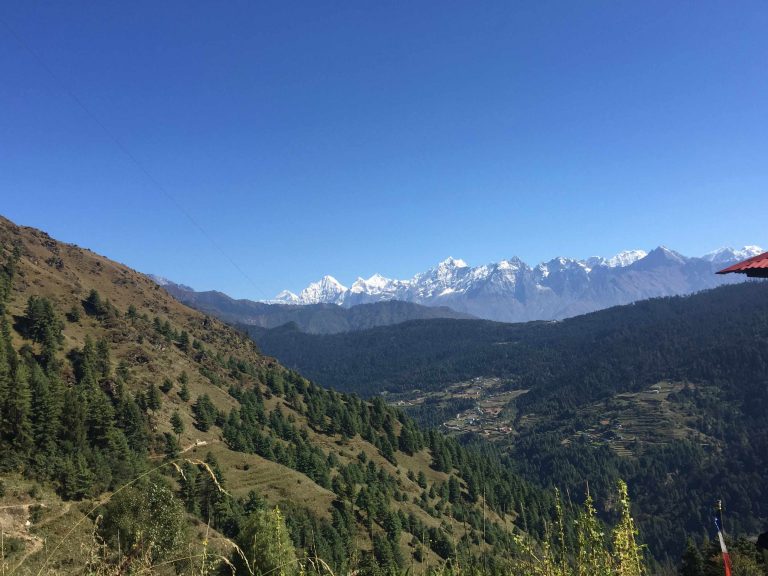 best Everest ranges mountains view from a close distance
best Everest ranges mountains view from a close distance
trip- Highlights
- Trek to Namche, a busy mountain hub surrounded by mountain views.
- We trek through Tengboche and visit the beautiful, high altitude monastery.
- Hike up to Everest view hotel for a panoramic mountain view.
- Visit the biggest Sherpa villages in Khumjung and Khunde.
- Fly over mountains Kathmandu-Lukla- Kathmandu
(6) We stay in teahouses along the route and you can experience Nepalese food and culture first hand
Trekking to Everest view trek in October and November is the perfect choice for those who have a short time in Nepal and not enough time to reach Everest base camp, but still want to see world big mountains ranges from close distance in sunrise and sunset moment. Everest view trek route end at Tenbuche monastery alt. 3780m. You shall be enjoying with a week trek in Khumbu valley with a magnificent view of mt. Everest range, mt. Ama Dablam, Thamserku, Khonge peak, khumbila peak, khantega including several mountains. the trek start after 30 minutes fly to Lukla from Kathmandu, next few days you will trek through the Dudhkosi river until Namche bazzar alt 3400m., following days you will be a hike to Everest viewpoint hotel alt. 3800m for a fantastic panoramic view of mt. Everest (alt. 8848m), mt. Ama Dablam (alt.6893m), mt.Lohse (alt. 8516m), Nuptse, (alt7965m) Thamserku alt 6654m including many more Himalayas peaks. Continue you will be a trek to Khumjung, Khunde, Sherpa villages which are the biggest Sherpa habitation and monastery, where you can see real sherpa culture and religions and daily activities, and last final day of Everest view trek you will return back to Lukla and fly back to Kathmandu from Lukla Read more
(3) Everest base camp with Gokyo lake trek :
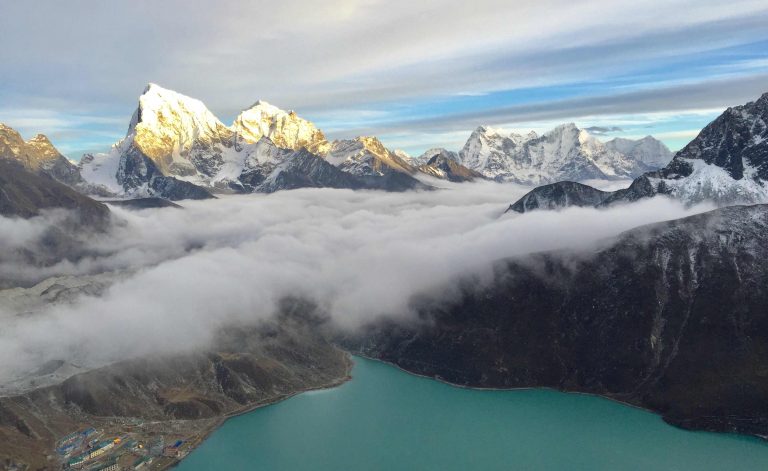
Trip-highlights
- Trek to Namche, a busy mountain hub surrounded by mountain views.
- We trek through Tengboche and visit the beautiful, high altitude monastery.
- Hike up to Everest view hotel for a panoramic mountain view.
- When we reach Base Camp (5364m), we have plenty of time for pictures and to explore this iconic setting.
- Cross highest Cho-la pass alt. 5361m. Among three high passes in the Everest region.
- Visit beautiful Gokyo valley and hike up to Gokyo- Ri viewpoint alt.5360m.
- Great hospitality and warm welcome by local Sherpa people and provided verities food and drinks in a tea house.
In October and November Everest base camp with Gokyo lake trek is a perfect time to visit with beautiful weather, in Everest region, Everest base camp with Gokyo lake trek is one of the most popular routes and this route is more adventure than Everest base camp trek, the routes are surrounded by incredible big mountains, landscape, Along the way you shall be crossing strengthen mountains view, sherpa habitations, old monastery many more, You will be trek first Everest base camp (alt. 5363m), and kalapather ( 5550m) then after, return to Gokyo valley via Chola pass (alt 5360m). during this trek you have three big highlights day like first reaching world highest mountains base camp E. B.C and fulfill your dream come true then following morning hike to Kala Patthar viewpoint for a magic panoramic view of whole Khumbu valley including Everest ranges and second highlights of this treks is cross Chola pass alt 5360m via Dzong-la, from top of Chola pass you have another great view of Mt. Everest and Ama Dablam, you would have great experience of a walk through the ice and rocky trail, and steeply descend of another side of Chola pass, third highlights of this trek is exploring then culturally and naturally beautiful Gokyo lake valley, after complete EBC and Chola pass, Gokyo valley is a most beautiful site in Everest region, you can see beautiful lakes, glacier, and Cho-yu mountain , Choyu is above 8000m among 14 above 8000m above high mountains in the world, following morning you can hike up to Gokyo –RI viewpoint alt. 5360m for another a magnificent mountains view and beautiful Gokyo lakes, last part of this trek you will be trek back to Namche – Lukla in fewer days, and where your trek ends than you will fly back to Kathmandu. Read more
(4) Gokyo valley with Renjo – la pass trek:
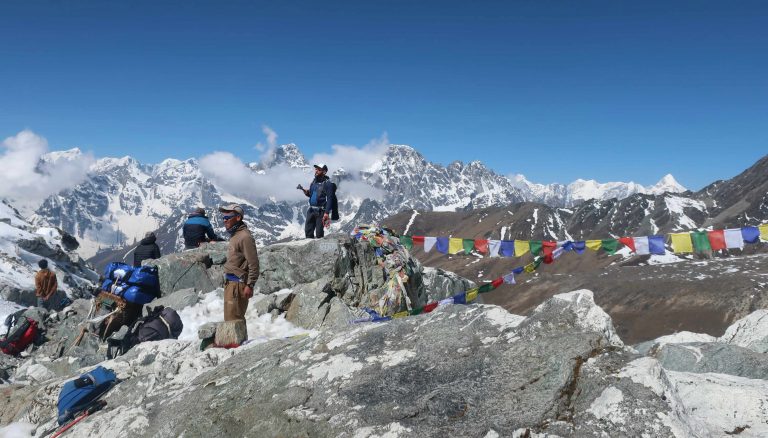 a magic view of the whole Everest region from the top of Renjola pass.
a magic view of the whole Everest region from the top of Renjola pass.
Trip Highlights:
- Trek to Namche, a busy mountain hub surrounded by mountain views.
- Visit the beautiful, Sherpa villages and monasteries in high altitude
- Hike up to Everest view hotel for a panoramic mountain view.
- When we reach Gokyo (4700m), we have plenty of time for pictures and to explore this iconic setting.
- Cross highest Renjo- la pass (alt 5391m) and enjoy watching amazing mountains view from a close distance.
- Visit beautiful Gokyo valley and hike up to Gokyo- RI viewpoint alt.5360m.
- Visit old villages where most of the Sherpa born to climb high mountains in the world.
- Great hospitality and warm welcome by local Sherpa people and provided verities food and drinks in the tea house.
October and November is the best time of year to visit in Gokyo valley with Renjo- la pass, If you want to hide crowed and want to see Mount Everest ranges in peace environments then Gokyo with renjo- la pass (alt 5360m) is one of the perfect choices for you, and Gokyo valley and Renjo- la pass trek route is another challenging trail in Everest region.
Afterward Everest base camp trek, Gokyo valley is another popular trekking trail in the Everest region. the trek begins after 30 minutes fly from Kathmandu to Lukla, then basically you shall start to walk from here, fewer days you will trek through the Dudhkosi river until the Namche bazaar, Namche bazaar(alt. 3400m) is famous local markets in Everest region, where you can spend your quality time with nice hot coffee, bakery, and delicious food, accommodation, generally, most of the trekkers stop here two night for high altitude digest, in rest day you will hike up to Everest view Hotel (alt. 3800m) for a panoramic view of mount Everest range (8848m), and Ama Dablam (6893m) including hundreds of others peaks are surrounded the viewpoint, an afternoon you have a free time to visit the local market.
Following days you will trek continue Gokyo valley via Kyanjuma – Mong-la dada (alt. 3800m) – Phorte Thanga (alt 3500m) –Dole alt 4200m. Machhermo (alt.4500m), before reaching in Gokyo (alt.4700M) you will be cross two lakes and finally, you will reach in the third lake where all tea house is located, you shall spend a night here and visit these beautiful lakes, glaciers, and mountains, in between Namche and Gokyo valley the trails are surrounded by mountains, Sagarmatha national park, Gokyo valley, and Renjo- la pass trek not only offer the view of the mountains, you can see different types of wildlife, (leopard, black beer, dare, the forest got, etc.), flora, fauna different types of birds, Dafe, Monal, wood picker, including our national birds many more..
Renjo- la pass (alt 5391m) is one of the popular and challenging high passes among three high passes in Everest region, this pass is located at the left above from Gokyo Lake or just opposite side of Gokyo –RI viewpoint, The trail Is more rocky and steep up till the top of Renjo La pass from Gokyo lake, most attraction from top of renjo la is a magic view of whole Everest regions mountains including five above 8000m high mountains like Everest(8848m) Choyu (8150m) ,Lotshe shar(8516m), Kanchenjunga (8586m) , Makalu( 8485m), and the many Himalayas peaks from the region. From top, you will be descending to another side of renjo la pass to Lingden – Thame, and next few days trek back to Lukla via Namche where your trek ends with best trekking experience in short time Read more
(5) Annapurna circuit trek :
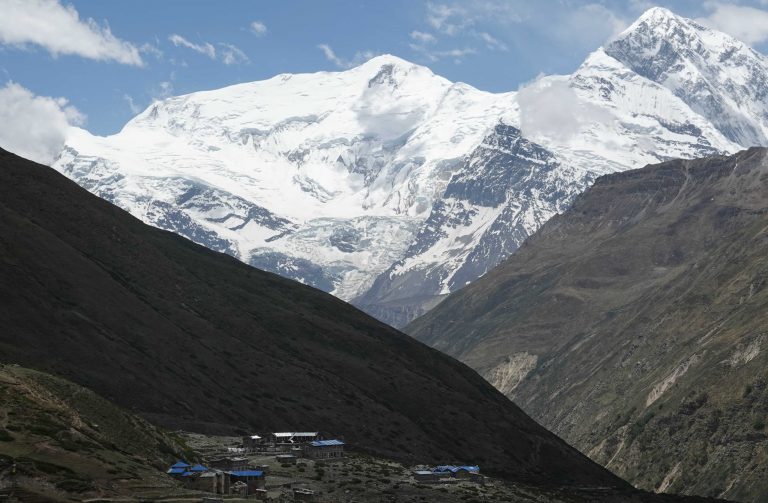 (Annapurna is one of the popular trekking route, where we can see several mountains from a close distance)
(Annapurna is one of the popular trekking route, where we can see several mountains from a close distance)
Trip -Highlights
- Cross the highest pass in the world Thoron-la pass (alt 5416m.)
- Explore the two above 8000m high mounts mt. Annapurna I (alt 8091m) and mt. Dhaulagiri alt.8167m)
- Visit Manag and Pisang old Tibetan villages and monastery.
- Visit Tilicho Lake which is the highest Lake in Nepal.
- Enjoying watching a magnificent Annapurna and Dhaulagiri mountains view from a close distance.
- Visit old monasteries, temples, museum and local people daily activities, and their culture and religions.
- A Scenic drive from Kathmandu to the trekking starting point, and Great trekking experience in your lifetime,
- Enjoy delicious food and stay at their local tea house.
Trekking to an Annapurna circuit an October/Nov is the best choice for all trekking and hikers, in perfect weather, you shall have a great time an Annapurna circuit trek, Oct/Nov is always the best time of year for visiting Nepal for any outdoor activities. From the beginning of the trek to the end of the trek you will have full of enjoying with nature, culture, and landscapes of the Annapurna region.
In the begging of Annapurna circuit trek you will be an encounter with full of paddy farmlands in autumn, and day by day you will ascending 4 to 500m higher in different places, Once you reach above 3000m high from Pisang villages, you will start to see Annapurna ranges mountains like Annapurna II, (alt 7939m), Annapurna III (alt.7535m), Annapurna IV (alt 7525m), Gangapurna (7436m), and including many mountains peaks. Along the way to Annapurna circuit trek, you will be crossing several local habitations, fertile lands, waterfall, beautiful landscapes, culture, nature, and regions of the region.
In Manag villages (alt. 3500m) most of the trekkers stop one extra day for high altitude digest, because of the further you need to go higher and you have to cross world long and high pass Thorong- la pass (alt 5416m) before reaching Muktinath Temple another side of Annapurna mountains.
Annapurna circuit trek becomes a shorter then before because of the car rode reach in Manag (alt 3500m), so you can skip some trek part in begging of the trek, and start your trek from bit higher place like Dharapani (alt 2400m) or Chame villages (alt 2600m), we don’t advice to trekkers to go direct until car rode end because of them if you go direct higher elevation from a lower elevation it can be dangers from high altitude sickness, so better start from lower part the route and go higher slowly and complete trek comfortable read more
(6) Mardi Himal Trek:
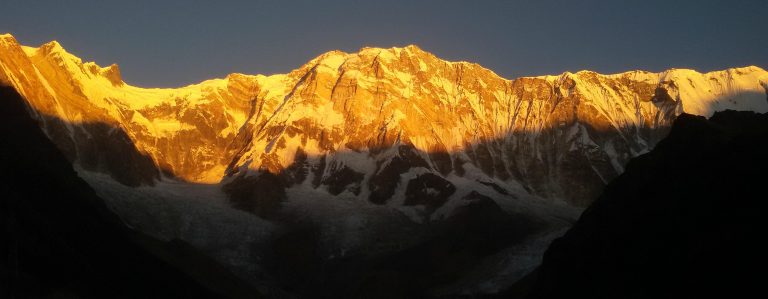 (Sunrise view on (Mt. Annapurna I (8091m)from Mardi Himal viewpoint)
(Sunrise view on (Mt. Annapurna I (8091m)from Mardi Himal viewpoint)
Trip – Highlights
- One of the views of the whole Annapurna mountains ranges from a close distance.
- A great chance to meet with local people and their culture.
- Enjoying watching a magnificent Annapurna and Dhaulagiri mountains view from a close distance.
- Visit old monasteries, temples, museum and local people daily activities, and their culture and religions.
- A Scenic drive from Kathmandu to the trekking starting point, and Great trekking experience in your lifetime,
- Enjoy delicious food and stay at their local tea house and Homestay.
If you are looking for a short trek in Nepal in Oct/Nov then Mardi Himal trek is a perfect route in the Annapurna region. Mardi Himal trek is popular for a magnificent mountain view of Annapurna, Fishtail (Machhapuchre), Dhaulagiri and Manaslu range including beautiful Landscapes, culture, nature, and religions. Mardi Himal trek is quite challenging and higher trekking route in Annapurna region, Beautiful Mardi himla trail offers from begging of a trek to end of the trek, a panoramic view of the Annapurna and Fishtail mounts from a close distance, and mix culture, and religion On this trek you will not only watching mountains view you shall encounter the fertile filed which full of paddy, waterfall, suspension bridge, local people habitation much more.
6 days Mardi Himal trek begins after one hour drive from Pokhara to Phedi or Kade, beginning of the trek the trail goes through the local villages and continue few days trek into the forest until the high camp of Mardi Himal. Once you reach in Mardi Himal viewpoint (Alt 4500m) you will see strengthen the view of south Annapurna alt 7210m, Himal chuli alt. 6430m., fishtail alt.6993m. , Gangapurna alt. 7435m., Annapurna III alt 7535m, including two above 8000m high mountains Annapurna I alt. 8091M and Dhaulagiri alt.8167m. after exploring all the above panoramic mountains view we shall trek back to Pokhara before we back to Pokhara you will spend some nights in local Homestay with a warm welcome and delicious food Read More.
(7) Annapurna base camp trek via Poonhill :
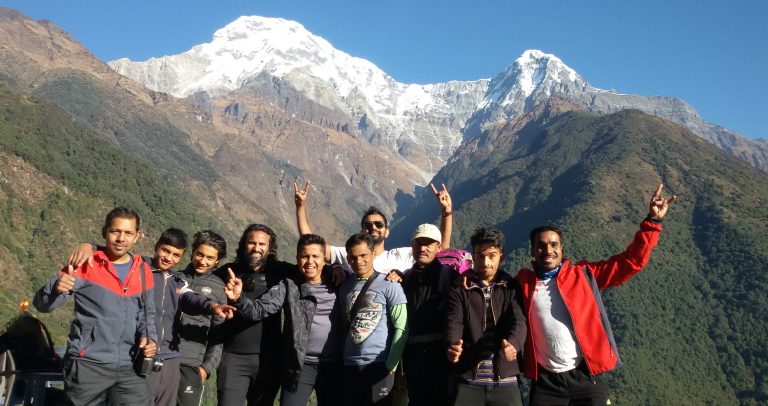
Trip- Highlights:
- Enjoying watching a magnificent Annapurna and Dhaulagiri mountains view from a close distance.
- Visit old monasteries, temples, museum and local people daily activities, and their culture and religions.
- A Scenic drive from Kathmandu to the trekking starting point, and Great trekking experience in your lifetime,
- Enjoy delicious food and stay at their local tea house.
- A magnificent Annapurna and Dhaulagiri sunrise view from Poonhill viewpoint 3210m.
- Visit the biggest glacier an Annapurna base camp with sunset and sunrise view.
- Take a natural hot bath in Jhinu dada before end trek, and many more…
The Annapurna Region is the most popular area for trekking. This region is very cultural with many different castes in this area, ie Magar Gurung, Chhetri, and many more. The people in this region are hard-working, happy and very friendly. The lodges and tea houses are colorfully painted and decorated. The people in this region are Hindus and Buddhists and celebrate many festivals including Deepawali, Lhosar, Teej, and New Years, and while celebrating they want tourists to be included.
It’s a deep glacier-covered amphitheater surrounded by a ring of impressive high peaks including Himchuli, Annapurna South, Fang, Annapurna, Ganagapurna, Annapurna III and Machhapuchh read more
(8) Manaslu circuit trek :
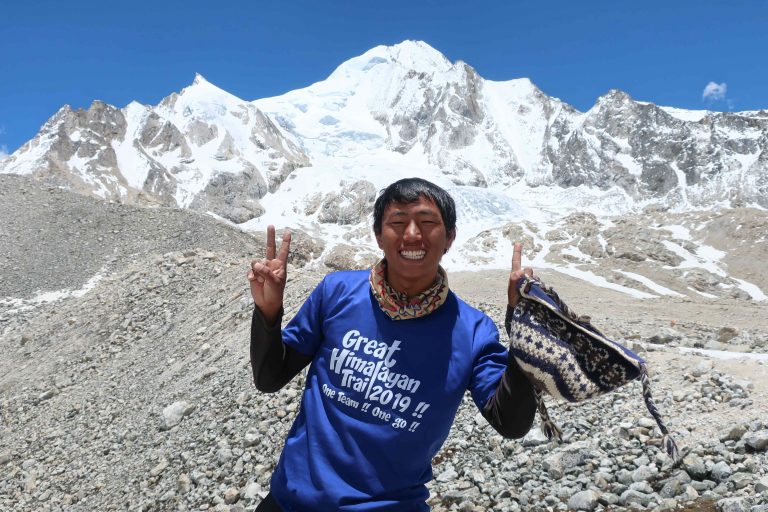 Manasalu circuit trek.
Manasalu circuit trek.
Trip Highlights.
(1)Cross Larke-la pass alt.5130m.
(2)Great experience of walkthrough Budhigandaki River for several days.
(3)A magnificent view of Manaslu I (alt 8167m), including many 7000m and 6000m. High mountains.
(4)Visit old Tibetan villages and monasteries, and museums.
(5)Hike up to Manaslu base camp or Mahendra Lake from Sama gaun.
(6)Trekking through the Budhigandaki river valley and take a natural hot bath.
(7)Experience of delicious food and real Test of real Nepali food and warm welcome by locals in their homestay and Tea house.
Mt. Manasalu is the seventh-highest mountains in the world (alt. 8167m), Manaslu mountain region offers beautiful trekking and climbing route among of them Manaslu circuit is one of the favorite trekking routes for all adventure lovers, trekking in Manaslu in October/ November is the best idea to make a plan for a clear panoramic view of Manaslu and Himal Chuli, also you will be visiting six – seven hundred years old Tibetan village, an old monastery, and Chhorten along the way. Larke la pass cross (alt. 5130m) is another highlight part of Manaslu circuit trek,
Manaslu circuit trek is located at west from Kathmandu in Gorkha district, in between Annapurna Mountains massive and the border with Tibet, China.
The trek begins after 6 to 7 hours drive from Kathmandu to Aru Ghat or Soti Khola by local bus, (approx 180km.) beginning of the trek you shall trek through the Budhi Gandaki river banks until the Low gain (alt.3500m) for 4 to 5 days. Once you reach in Low gaun then after you will see the first and perfect view of mount Manaslu range from a close distance, you will be continually trekking to Sama gaun(alt.3900m) Sama gaun is the capital village of the Manaslu region, you are going to stay one extra night here for high altitude digest, on this day you can hike up to Mahendra lake or Manasalu base camp before dinner after breakfast, following days you will continue trek to Samdu- Dharmasa –la, and finally you will cross the highest pass of the region call Larke –La (alt 5130m) , and trek back to another side of Manaslu in Bhimthang, and then next day continue descending to Darapani where Annapurna circuit classical trail you will meet and drive back to Kathmandu via Beshishar Read more
(9) Makalu base camp :
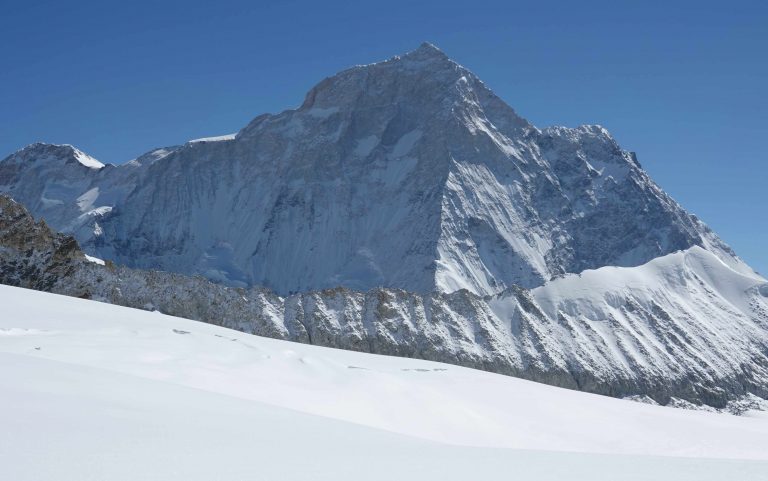 (Mt. Makalu (alt. 8416m)
(Mt. Makalu (alt. 8416m)
Makalu Base Camp trek is an absolutely amazing, still very untouched area in the northwestern corner of the Sankhuwasabha district. To the west, it is bordered by the Everest region, to the north by Tibet, to the east by the Arun River and to the south by the Sabha River. It just so happens that this very pristine area was turned into a national park and conservation area in the early 1990s. The park is still at its beginning stages. Though struggling to make its mark, it has done fairly well. Unlike the Annapurna Conservation Area Project (ACAP), the Makalu Barun Conservation Project (MBCP) is set up differently. Makalu-Barun National Park, a virtually uninhabited 1500-km2 area of Eastern Nepal, is very close to virgin wilderness. This remote terrain stretches east from Sagarmatha (Mt. Everest) National Park, between the high plateau of Tibet and the deep subtropical gorge carved by the Arun River. There are spectacular views of rugged Himalayan peaks, including Mt. Makalu (8463m), fifth highest in the world, Mt. Chamlang (7319 m) and Mt. Baruntse (7129m). Within 40 km, these high peaks descend to the Arun River at 670m. The Makalu-Barun Valley provides stunning contrasts, where high waterfalls cascade into deep gorges, craggy rocks rise from lush green forests, and colorful flowers bloom beneath white snow peaks read more
(10) Kanchenjunga Base camp trek:
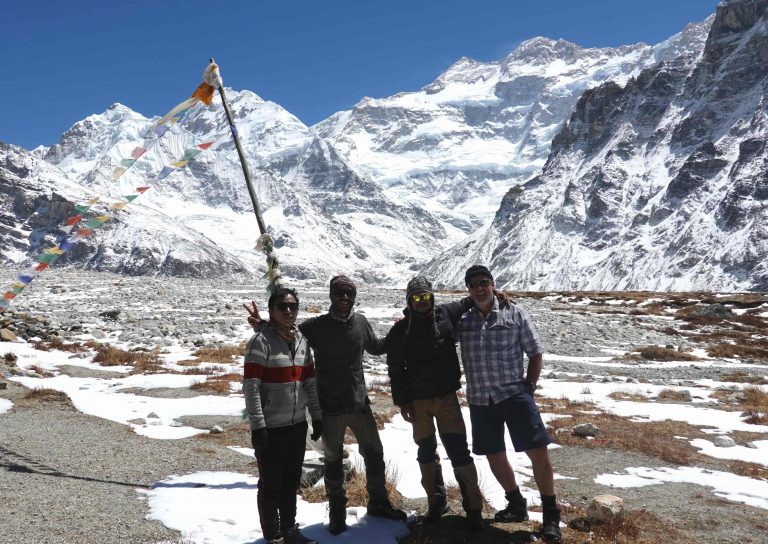 Mt. Kanchenjunga (alt.85 86m.)
Mt. Kanchenjunga (alt.85 86m.)
Kanchenjunga (8598m) is the world’s third-highest mountain with many other popular mountains, Jannu (Kumbhakarna), ChhangHimal, and many more snowy peaks. At the start of this adventure, you will encounter the Limbu and Rai culture which is part of the Hindus culture. In October they have a festival to celebrate Uvauli. This festival is the celebration of harvesting the crops from the fields and bringing to their homes. They also celebrate in May sowing of the crops which is called Udhauli. This area is also where the Ghurkkas are recruited. Wildlife is in abundance in this area, for example, Blue Sheep, masked deer, and the snow leopard. There are also many Yaks are in this area. After a week we encounter the area where the Sherpas culture exists. From Pangpema we will see the north face of Kanchenjunga. Traversing the remote and rarely visited northeastern corner of Nepal, our route leads through picturesque farmland, green alpine valleys, rhododendron and bamboo forests, and across High Mountain passes. Beyond the attractive Tibetan settlement of Ghunsa, with its sturdy wooden houses, numerous prayer flags, and smiling villagers, we skirt the incredible northern flank of Jannu (7710m). From Pang Bema (5140m), the base camp, we enjoy the breath-taking view of the formidable north face of Kanchenjunga. With this trek being medium-difficult you will have an amazing adventure. read more
(11) Langtang valley with Gosaikunda lake trek :
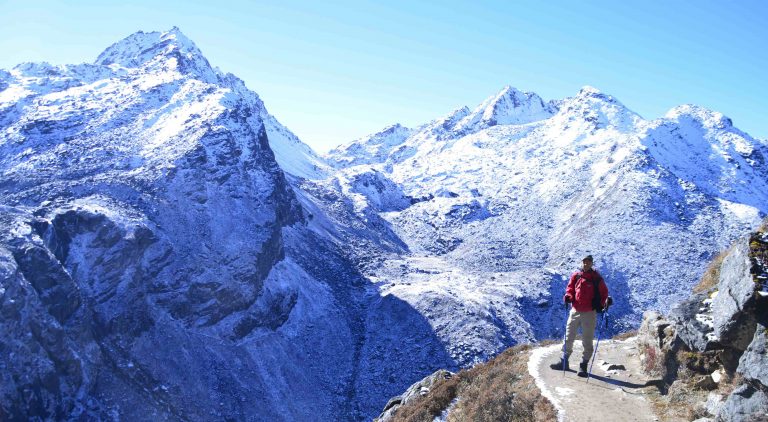 Langtang valley and Gosaikunda lake trek
Langtang valley and Gosaikunda lake trek
Trip- Highlights
- A scenic drive from Kathmandu to the trekking start point.
- Visit 600 to 700 old Tibet villages and see their daily life activities.
- Great view from a close distance to all Himalayas of the region.
- Good chance to taste real yak cheese and visit a cheese factory.
- Hike to Kyanging -ri viewpoint to see whole Langtang valleys mountains and Langtang lirung glacier from a close distance.
- Visit Holy Lake of Gosaikunda and hike to Surya peak for a great view of the Annapurna region, Manaslu region, and Langtang region.
- Experience of delicious food and real Test of real Nepali food and warm welcome by locals in their homestay and Tea house.
The Lantang and Gosaikunda lake regions are located north of Kathmandu, this region is known for its natural beauty and wide and varied trekking opportunities passing through the lush Rhododendrons forest, filled with conifers and oaks you will have plenty of opportunities to immerse yourself in the natural surroundings and wildlife. We will pass and meet many cattle along the way. Monkeys’ and a wide variety of birds are always within sight. From Langtang valley, we take the trail up to the sacred site called Goisaikunda Lake. GosainkundaLake is believed to have been created by Lord Shiva when he thrust his Trishul (trident) into the mountain to extract water so that he could cool his burning throat after swallowing poison. At the lake, you will also have spectacular views of the Ganesh Himal range and Manaslu range. After crossing the Laurebinae pass (4600m), we trek back via another route in this region. This route takes us back to Kathmandu via Kutumsang, Chisapani, and finally Kathmandu. Read More
(12) Langtang valley trek :
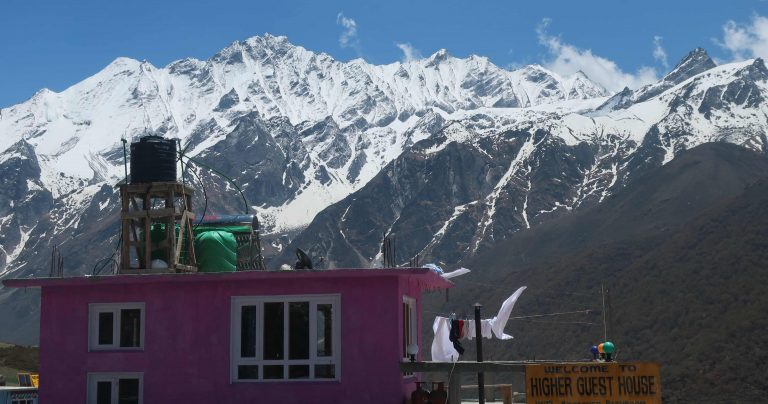 Mount Gangchhembu in the Langtang region.
Mount Gangchhembu in the Langtang region.
Trip- Highlights:
- A scenic drive from Kathmandu to the trekking start point.
- Visit 600 to 700 old Tibet villages and see their daily life activities.
- Great view from a close distance from all Himalayas of the region.
- Good chance to taste real yak cheese and visit a cheese factory.
- Hike to kaynging- ri viewpoint to see whole Langtang valleys mountains and Langtang Lirung glacier from a close distance.
- Experience of delicious food and real Test of real Nepali food and warm welcome by locals in their homestay and Tea house.
The Lantang valley trek located north of Kathmandu. This region is known for its natural beauty and wide and varied trekking opportunities.
We start from Kathmandu, where we transfer by bus or private jeep the 147km to Dhunche- Sybrubesi. It is here at Sybrubesi that we start the trek. The trail leads us gently and slowly up through the many different villages inhabited by Tibetans, Tamangs, and Sherpa people.
The route provides us with stunning mountain views of Lantang Lirung, Yala peak, Ganchhepu Himal range, Nyakhang peak, to name but a few. This trek allows you to witness the changing landscape as we ascend above 3000m – when the landscape loses its vibrant green forest in favor of higher altitude backdrops Read more
October and November trekking suggested packing list:
- 1 hiking boots
- 1 Medium size backpack
- 1 Day pack
- 1 Sleeping bag (- 20C)
- 1 Down Jacket/Gore tax Jacket
- 1 Light wind & waterproof jacket
- 1 Inner sleeping sheet
- 2 Long-sleeve T-shirts
- 1 Water bottle
- 1 Pair gaiters/over trousers
- 1 Pair sports shoes or sandal
- 2 Pairs of lightweight trousers
- 1 Pair shorts
- 1 Fleece / warm sweater
- 2 T-shirts
- 2 Pair’ light socks
- 3 Pairs of heavy wool socks
- 1 Sweatshirts/light sweater
- 1 Torch & spear batteries
- 1 Swimming costume/bathing suits (not for Everest region)
- 1 Medium size towel
- 1 Washing kit including washing powder, small clothesline, and pegs, insect repellents, etc. & personal toiletries
- Moleskin for blister
- Toilet paper, biodegradable soap/shampoo(toilet paper you can buy every place in Nepal)
- Personal medication. (if you are taking rebury otherwise for high altitude we provide)
- Underwear (including thermals)
- Warm hat/ gloves
- Sunglasses, sun hat, and sun cream
- Spear plastic bags for wrapping clothes
Note: even high altitude medication you can bring in your favor like Diamox otherwise Nepalese taste we do have always (but we treat naturally all the time go slowly and drink lots of water)
What is the temperature in Oct /Nov in Nepal?
October and November, the temperature is perfect for travel to visit Nepal; we highly suggest you please make your holiday plane in these months. On the side of the mountain, the temperature will be 18 to 20 during the way and at night 14 to 16 in October, but in November the temperature will fall in the mountainside to 13 to 15 during the day and night time 8 to 10. Also, its depend in which place you are going for trekking or climbing?, if you are in higher place like Everest region, Annapurna region, Manaslu region, Kanchenjunga region, Makalu region then it could be colder than in lower place of the trek, as much as you go higher the temperature will be also colder, but lower parts of Nepal or in city areas such as Kathmandu, Pokhara, Chitwan, and Bardia place are hotter like still summer, you won’t feel colder.
So about the temperature in Nepal it depends on which place you go, if you go adventure trek, peak climbing, high passes trek then off course it will be colder. So the weather is never predictable, we highly suggest you please prepare well and bring warm and nice clothes for trekking or climbing in Nepal.
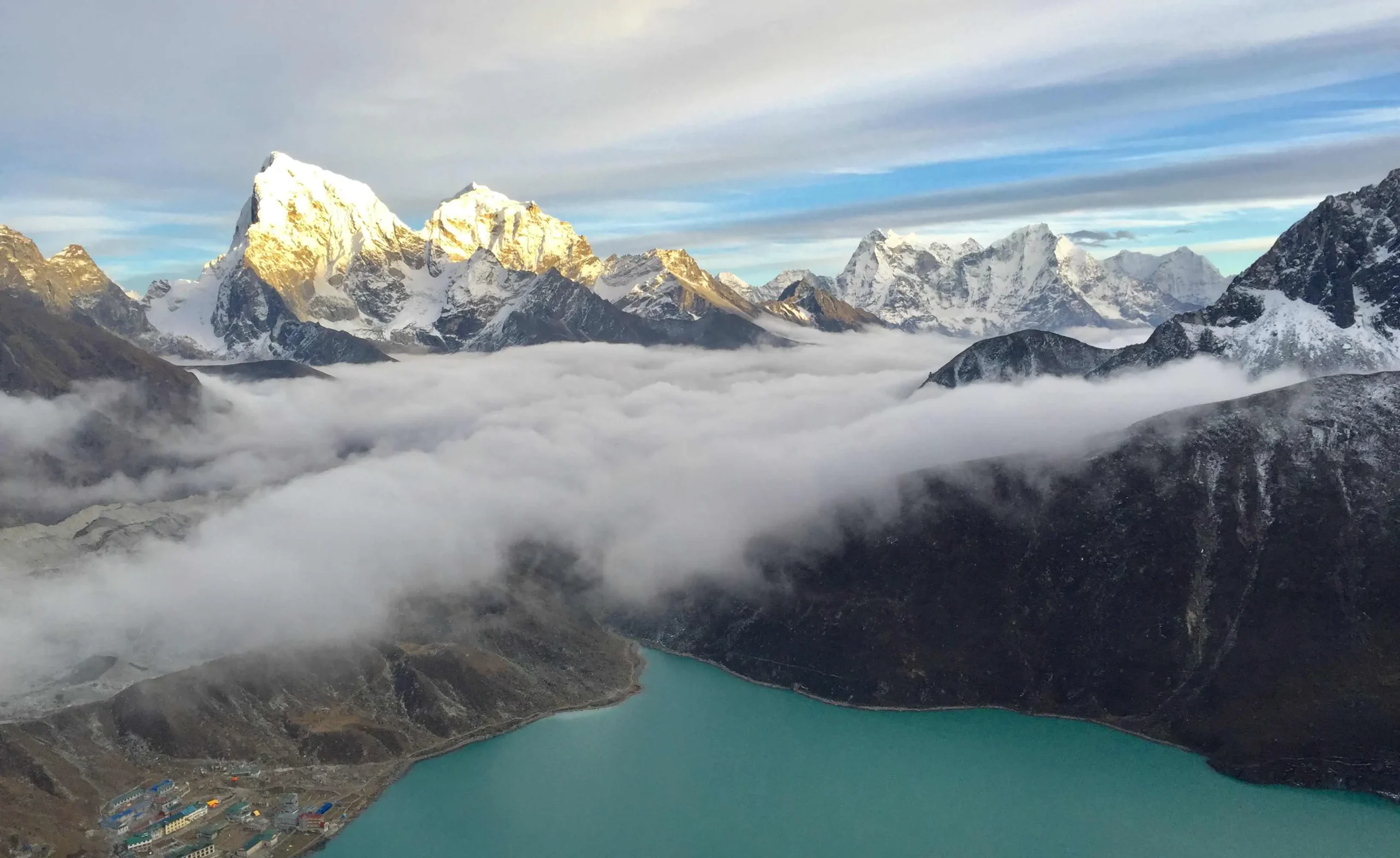

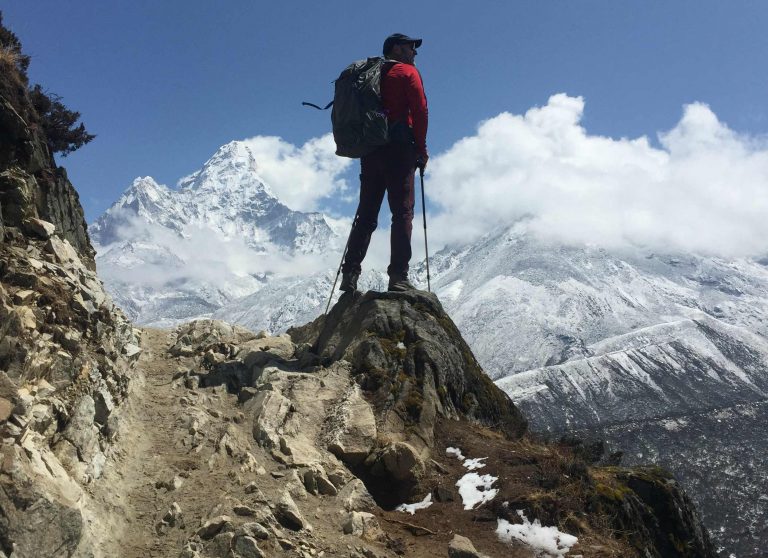 beautiful mountain view from Pangbuche Villages.
beautiful mountain view from Pangbuche Villages.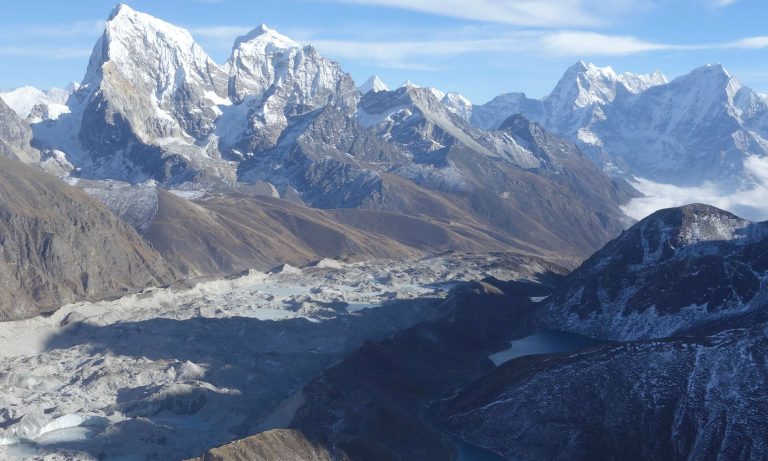 The best view from the top of Gokyo RI to the Himalayas
The best view from the top of Gokyo RI to the Himalayas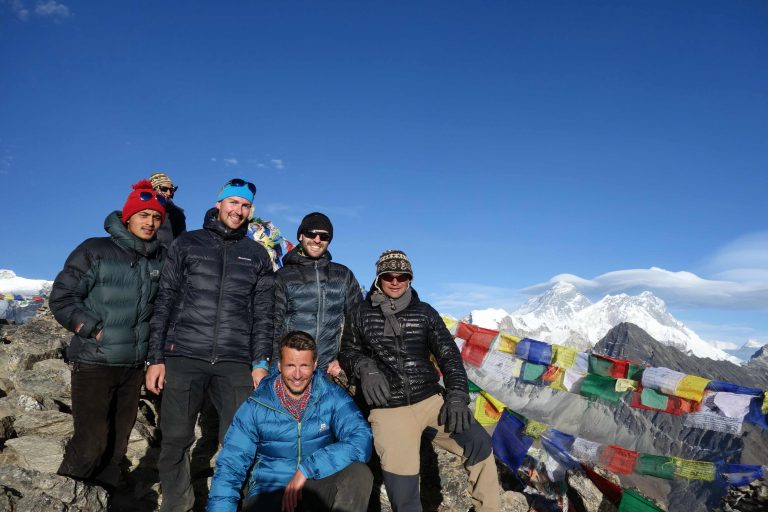 great view from Gok yo- ri top alt. 5360m.
great view from Gok yo- ri top alt. 5360m.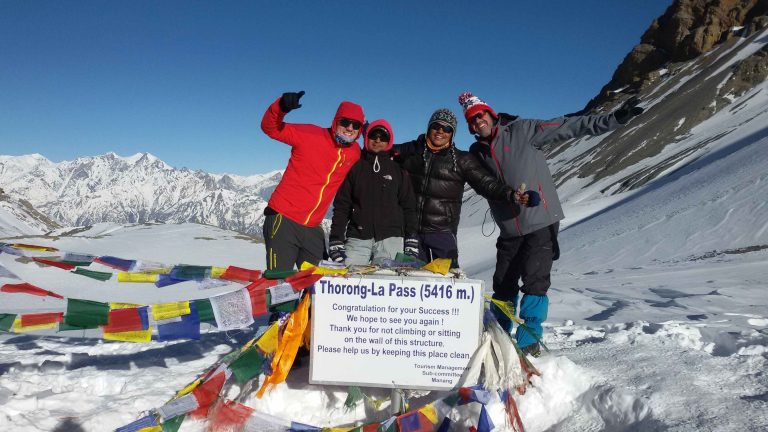 One the top of the Thorong la pass alt 5416m.
One the top of the Thorong la pass alt 5416m.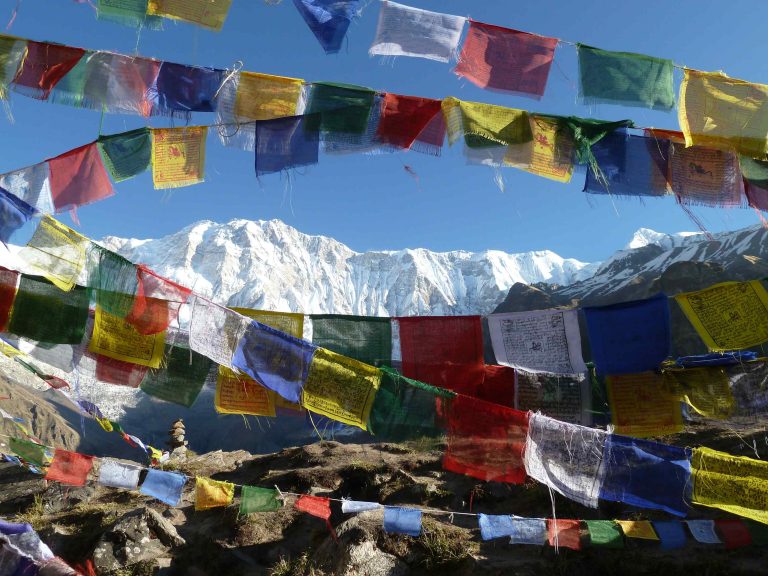 mount Annapurna I VIEW from ABC basecamp
mount Annapurna I VIEW from ABC basecamp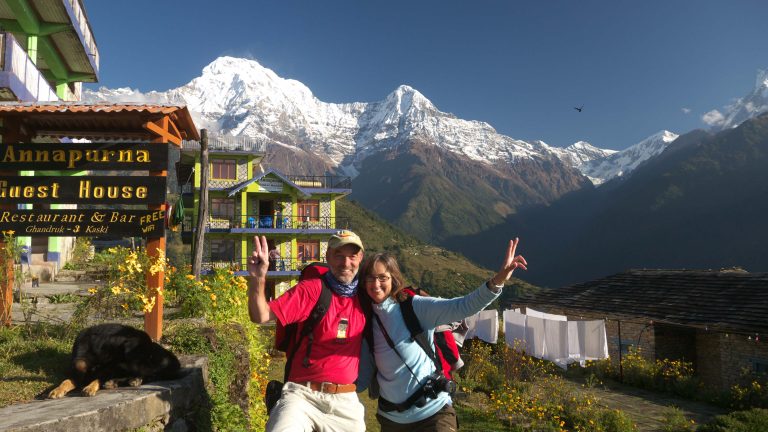 One the way up to mardi himal basecamp.
One the way up to mardi himal basecamp.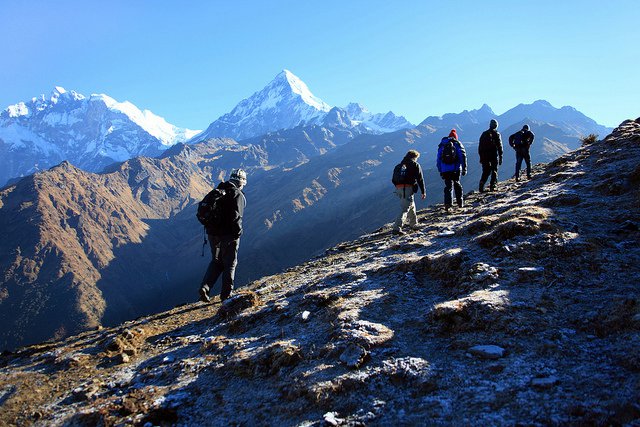 One the way to Khaire lake from Khobra dada. alt 3800m
One the way to Khaire lake from Khobra dada. alt 3800m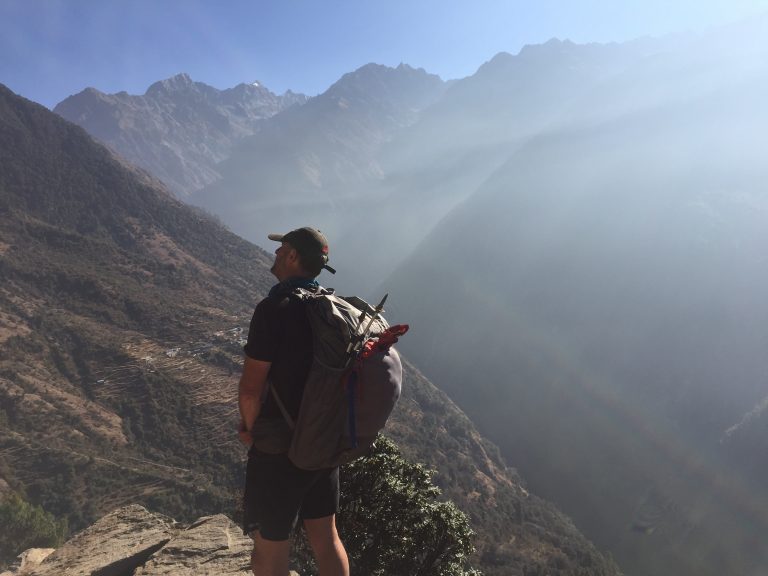 looking mountain view from Langtang villages.
looking mountain view from Langtang villages.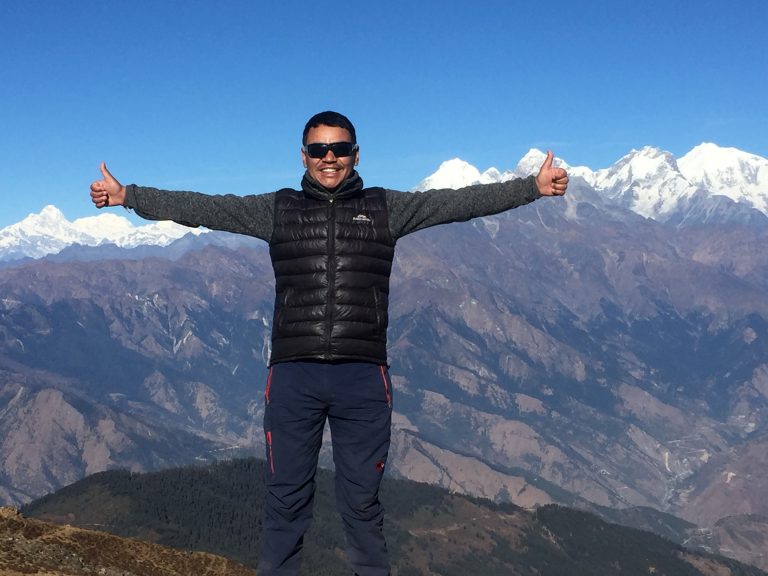 Enjoying mountain view from laurebinae pass
Enjoying mountain view from laurebinae pass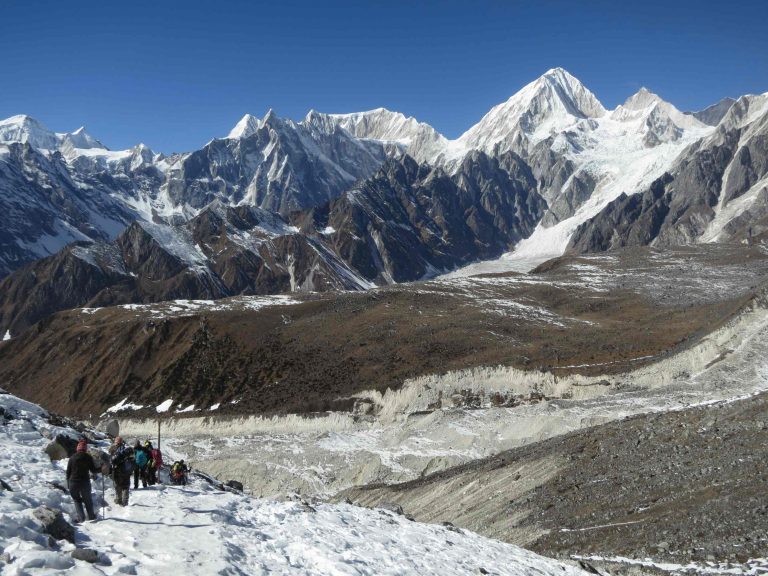 Descending to Bhim Phedi from larke -la top alt.5130m
Descending to Bhim Phedi from larke -la top alt.5130m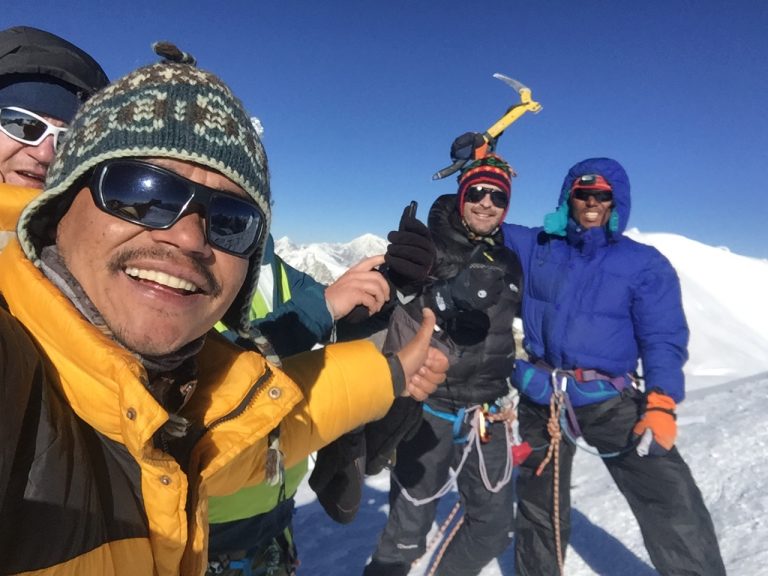 On the top of the Mera peak alt 6461m.
On the top of the Mera peak alt 6461m.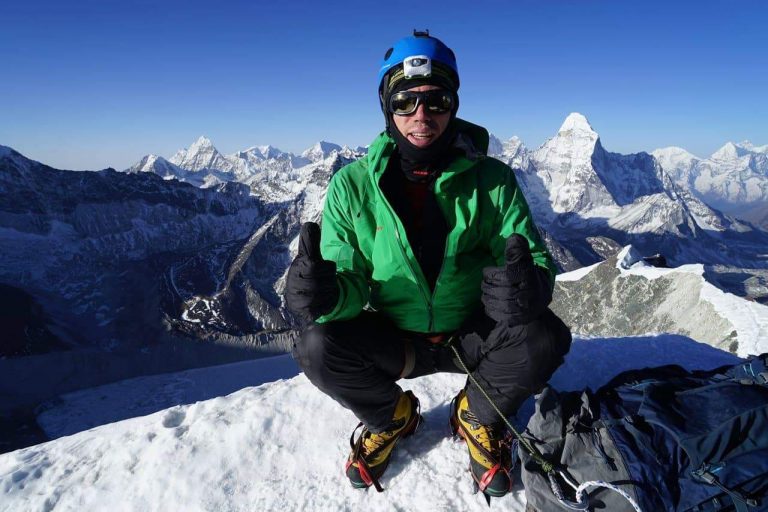 On the top of island peak alt 6176m.
On the top of island peak alt 6176m.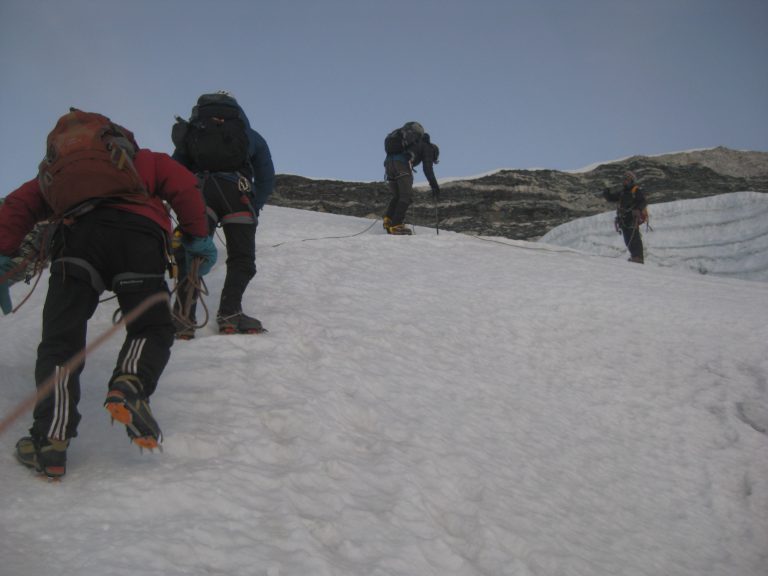 Near summit to Chulu east far
Near summit to Chulu east far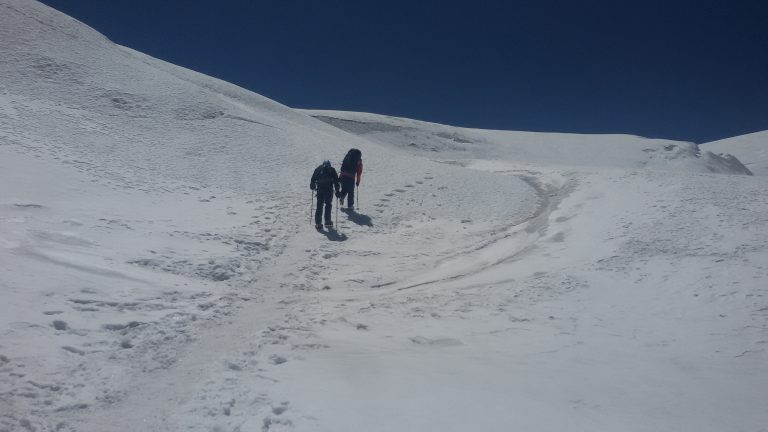 summit day
summit day
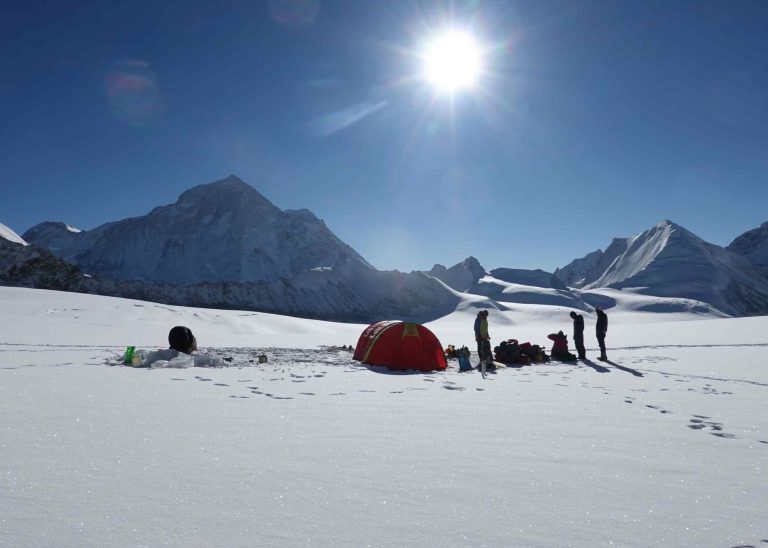
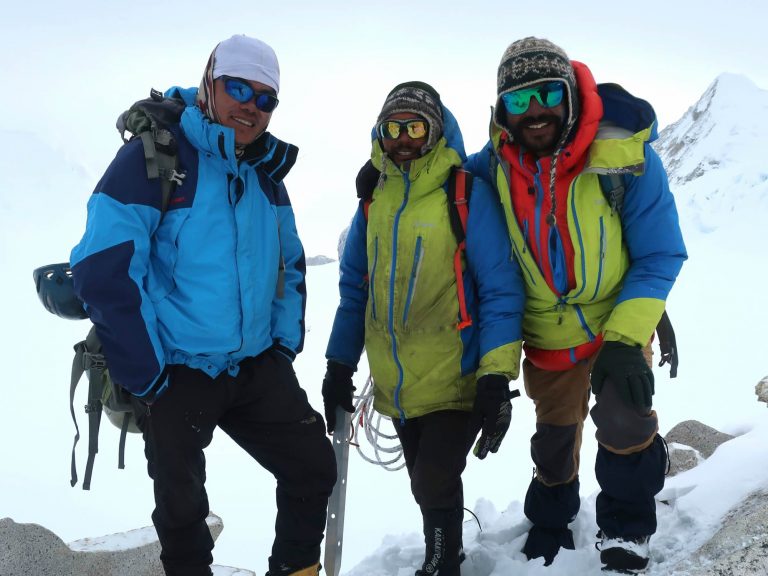
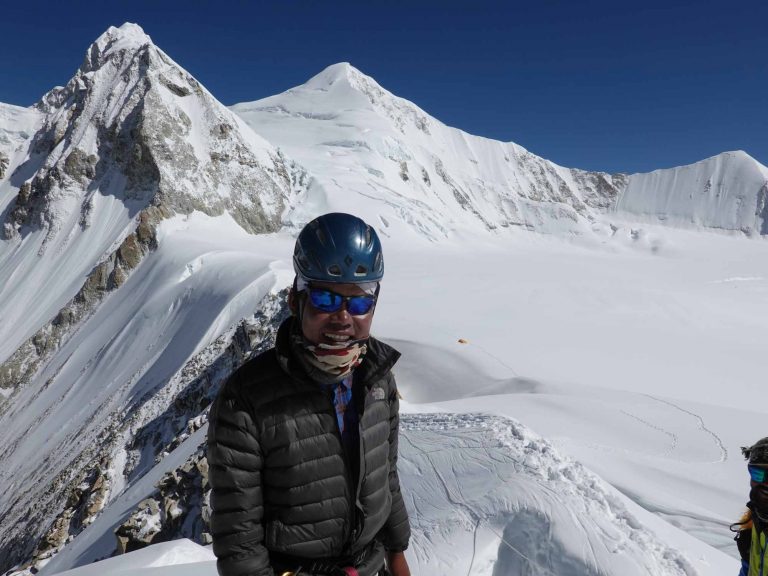
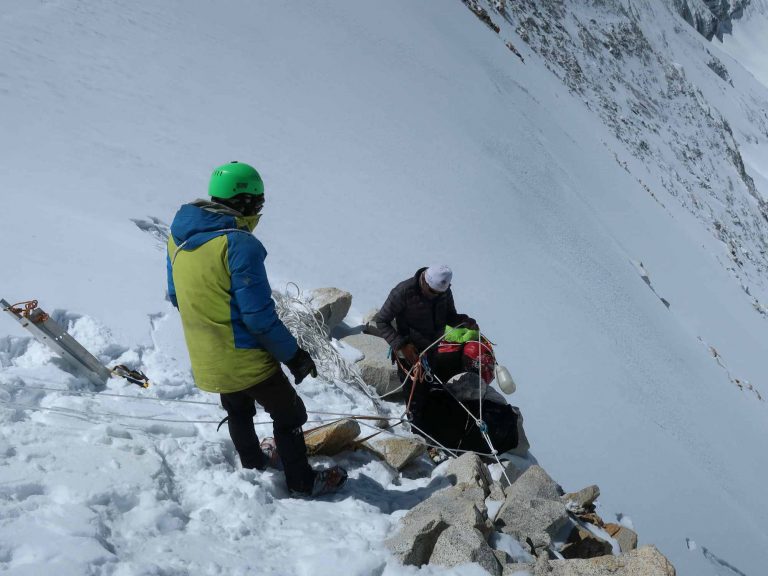
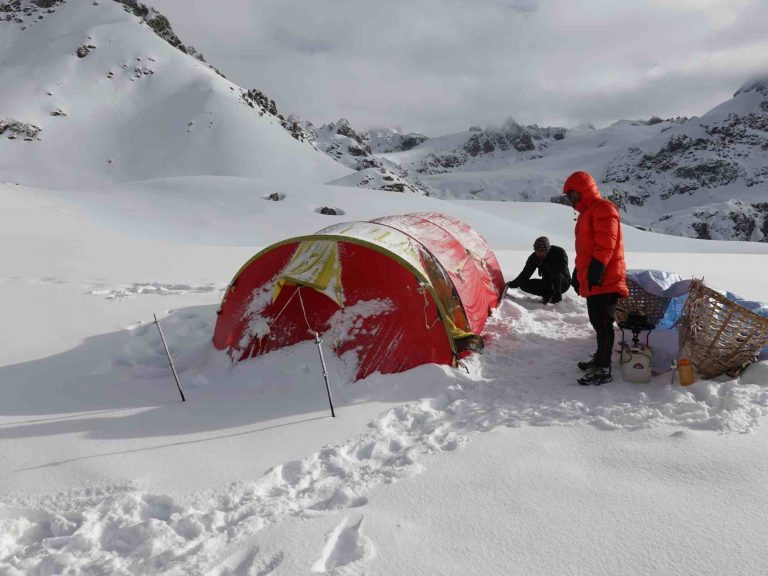

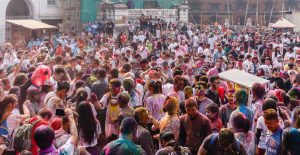
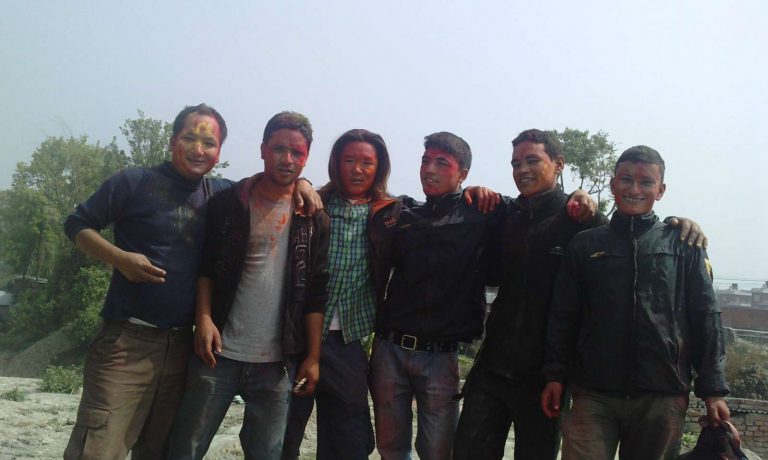

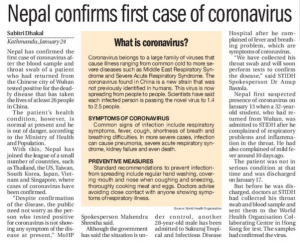
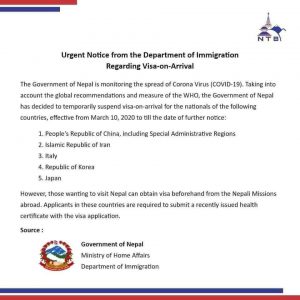
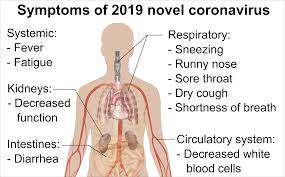

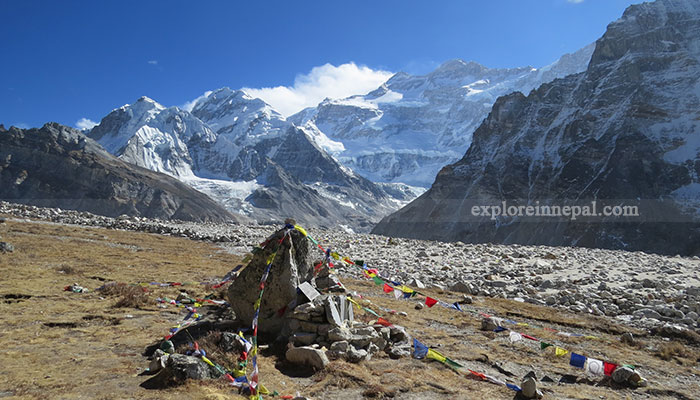

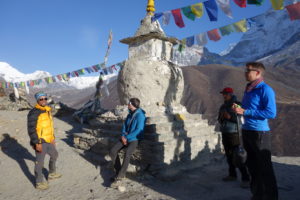

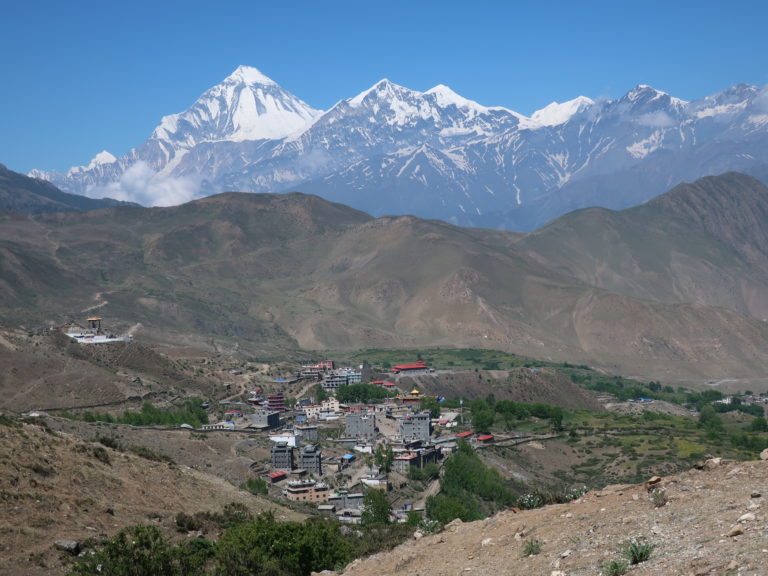 Muktinath Nepal.
Muktinath Nepal.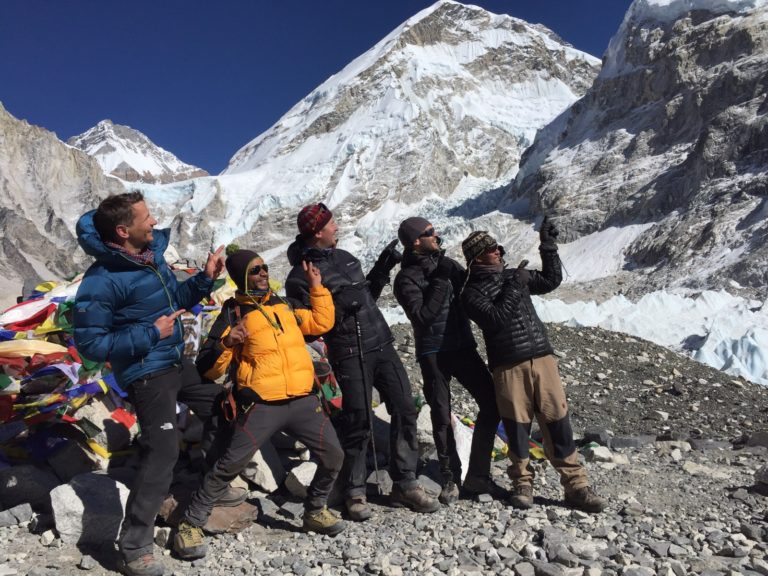 Everest base camp Alt. 5360m.
Everest base camp Alt. 5360m.